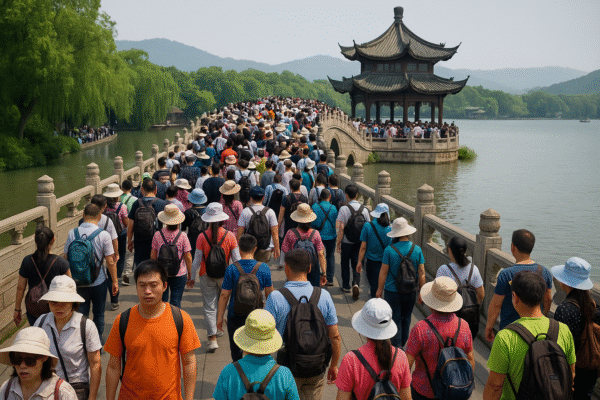China’s domestic tourism industry is witnessing a powerful resurgence in 2025, signaling a robust recovery from the impacts of the COVID-19 pandemic. According to data released by the Ministry of Culture and Tourism, domestic tourist trips reached 3.285 billion in the first half of the year—an impressive 20.6% increase compared to the same period in 2024. Domestic tourism revenue also soared to 3.15 trillion yuan (approx. USD 435 billion), marking a 15.2% year-on-year increase.
This remarkable growth underscores the sector’s resilience and reflects growing consumer confidence, renewed travel enthusiasm, and a cultural shift toward leisure and experiential travel.
Return to Pre-Pandemic Travel Habits
As pandemic restrictions fade into memory, Chinese citizens are eager to explore their own country again. Whether it’s scenic coastal provinces like Zhejiang and Fujian, historic capitals like Xi’an and Nanjing, or the serene mountain retreats of Sichuan and Yunnan, travelers are re-embracing mobility.
Notably, the revival isn’t limited to major tourist cities. There is also a palpable rise in interest for off-the-beaten-path destinations, aligning with a broader shift toward meaningful, slower travel experiences that emphasize culture, nature, and wellness.
Rural Tourism Takes Center Stage
Among the most striking trends of 2025 is the surge in rural tourism. The first half of the year saw a 30.6% increase in rural tourism activities, signaling a growing appetite for countryside getaways, agritourism, and eco-friendly retreats. The Ministry of Agriculture and Rural Affairs has emphasized rural revitalization through tourism, promoting village homestays, folk culture, and green development.
Tourism initiatives in places like Guizhou, Inner Mongolia, and Guangxi are creating new livelihoods while offering travelers a unique glimpse into traditional Chinese lifestyles. Local businesses—from family-run guesthouses to artisanal craft shops—are flourishing as tourism spending spreads beyond urban areas.
Social Media Sparks Travel Engagement
The role of digital platforms like Weibo, Xiaohongshu, and Douyin cannot be overlooked. Viral travel experiences and picturesque rural destinations are trending among younger travelers, with hashtags like #RuralRetreat and #ChinaHiddenGems generating millions of views.
Tourism boards are increasingly leveraging these platforms to promote lesser-known regions. This digital influence has played a crucial role in shaping modern travel preferences—especially among Gen Z and millennials—who seek immersive, Instagram-worthy experiences over traditional sightseeing tours.
Broad Economic Impact
The ripple effect of this tourism boom is being felt across multiple sectors. Hotels, transportation companies, food and beverage services, scenic attractions, and retail outlets have reported significant revenue increases. The airline and railway industries have expanded domestic capacity to meet demand, while local governments are investing in tourism infrastructure, from smart tourism platforms to improved transportation hubs.
Small businesses are thriving too. Artisans, local guides, ride-hailing drivers, and farmers offering agrotourism experiences are all beneficiaries of the increased footfall in their regions.
Government Support and Sustainable Growth
Recognizing the sector’s potential, the Chinese government is stepping up its support. Initiatives such as the “Beautiful Countryside” program and the expansion of high-speed rail access to rural provinces are crucial pillars in promoting inclusive tourism growth. The 14th Five-Year Plan outlines goals to modernize the tourism system, encourage innovation, and ensure environmental sustainability.
Sustainability is a key consideration going forward. With increasing footfall in ecologically sensitive areas, local governments and tourism operators are implementing guidelines to reduce overtourism, promote eco-friendly travel practices, and support community-led tourism models.
Innovation and Investment: The Future of Chinese Tourism
Investors are increasingly bullish on the tourism sector, especially with the advent of digital tourism, AI-powered trip planning tools, and immersive technologies like VR/AR for attractions. Capital is flowing into tourism tech startups and destination development projects, laying the groundwork for long-term growth.
In response to changing traveler expectations, many service providers are upgrading offerings to include personalized itineraries, wellness programs, and culturally enriching experiences. From smart hotels to digital ticketing and contactless payments, innovation is enhancing the travel journey.
Cultural Exchange and National Identity
As millions of Chinese citizens crisscross the nation, domestic tourism is strengthening national identity and cultural appreciation. Heritage sites, folk festivals, and culinary experiences are fostering a renewed interest in China’s diverse regional cultures. This internal movement is not only bolstering the economy but also enhancing unity and pride in China’s rich historical and cultural tapestry.
Challenges and the Path Ahead
Despite the optimistic outlook, challenges remain. High visitor volumes in hotspots like Hangzhou, Lijiang, and Zhangjiajie risk straining local infrastructure. Balanced regional development is essential to ensure sustainability. Policymakers are urged to promote under-visited regions while implementing visitor caps and conservation measures in popular sites.
Looking ahead to 2026 and beyond, the domestic tourism sector is well-positioned for continued growth. The blend of rising disposable incomes, digital innovation, strong policy support, and evolving consumer values makes China’s tourism landscape one of the most dynamic in the world.
For more travel news like this, keep reading Global Travel Wire





















